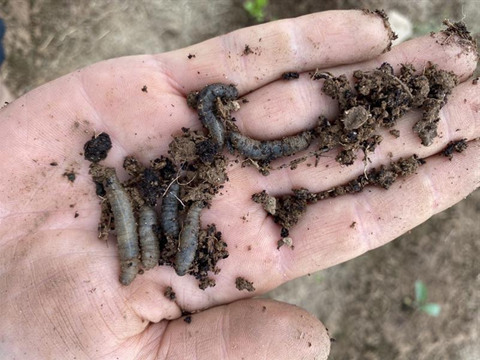Soil dwelling pests have devastated crops over the last
couple of weeks. Here is a quick guide to help you identify the potential insect causing the
damage you may have seen in your fields.
When scouting your field, the first sign of these pests is cut or wilted plants such as this lettuce transplant whose stem has been eaten away at the soil line.
Here are the most common culprits for this kind of damage:
Leather jacket
These are the larval stage of the crane
fly and will feed on roots of greens and other vegetables. Often, newly turned
over sod/pasture has a high abundance of leather jackets, especially on
wetter/heavier soils.
The above picture shows a heavy infestation of leather jackets.
These were collected from 10 linear feet of a lettuce bed. They can look visually
similar to cutworms however they don’t curl into a C shape and have an
unmistakable feeling in the hand; very little structure, almost like a tiny
water balloon.
Cutworm
The
most common cutworm we have is the black cutworm. They’re about 2 inches long
and will curl into a ‘C’ shape when disturbed.
These are a common pest and damage has been observed on: alliums, peppers, greens, brassicas, corn, and beans this spring.
They mainly attack young seedlings and often you will
observe localized areas of plants or leaves that have been cut off. Digging in
the soil around the site of attack will often expose the cutworm. They will
spend the day just under the soil surface and will come out at night to feed.
Wireworm
Wireworms are relatively common in agricultural fields and
predate the roots of a wide variety of agricultural crops.
Unlike leather jackets and cutworm, wireworm damage can be less obvious at first. They will nibble and consume roots, often the first sign will be your crop wilting in the midday heat. If they are not spotted, the wireworm can enter the stem of the plant, consuming it all as the below picture shows.
We have an excellent factsheet on wireworm identification,
and control options here: https://www.perennia.ca/wp-content/uploads/2020/05/WIREWORM-Fact-Sheet-final.pdf
How do they compare to each other?
The above picture shows the three pests side by side for comparison. Both the cutworms in have curled into their typical C shape while the larger leather jacket is trying to escape. The yellow wire worm is quite distinctive in comparison to the other two.
Tim





